“
Recently, teachers and students from Harbin Institute of Technology and Harbin Engineering University have been unable to use MATLAB, and this news quickly became a hot topic of concern….

Image from Pexels
Reflection on the MATLAB Ban: Domestic Software Must “Not Just Compete for Bread, but for Dignity”
On June 6, students using the legitimate version of MATLAB at Harbin Institute of Technology suddenly received a deactivation notification while using it. After clicking, they could still use it. However, just one day later, when they restarted MATLAB, it displayed an invalid license message.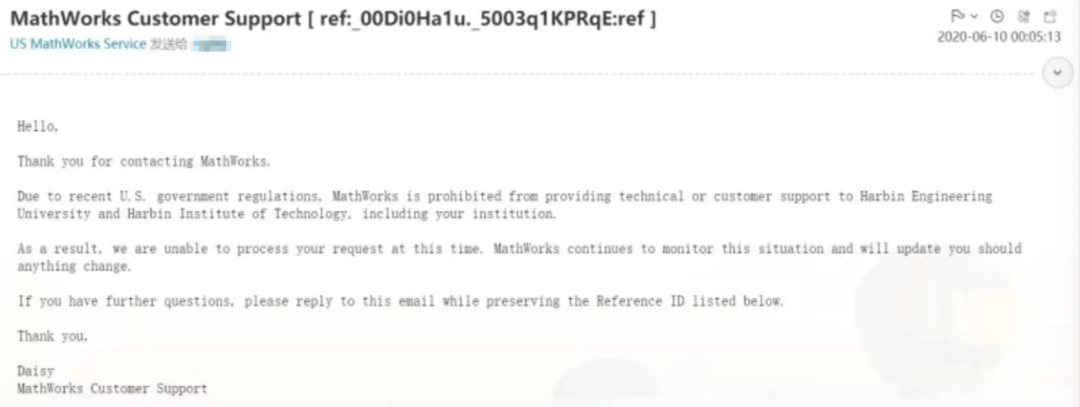
The company’s customer service replied: Unable to restore service
This is akin to buying a beautiful piece of clothing, only for the store owner to chase after you and take it back, claiming they no longer sell it. Why is this software company so indifferent to money?
Some employees expressed on social media that they were also helpless. As an American company, they can only comply with the White House’s ban.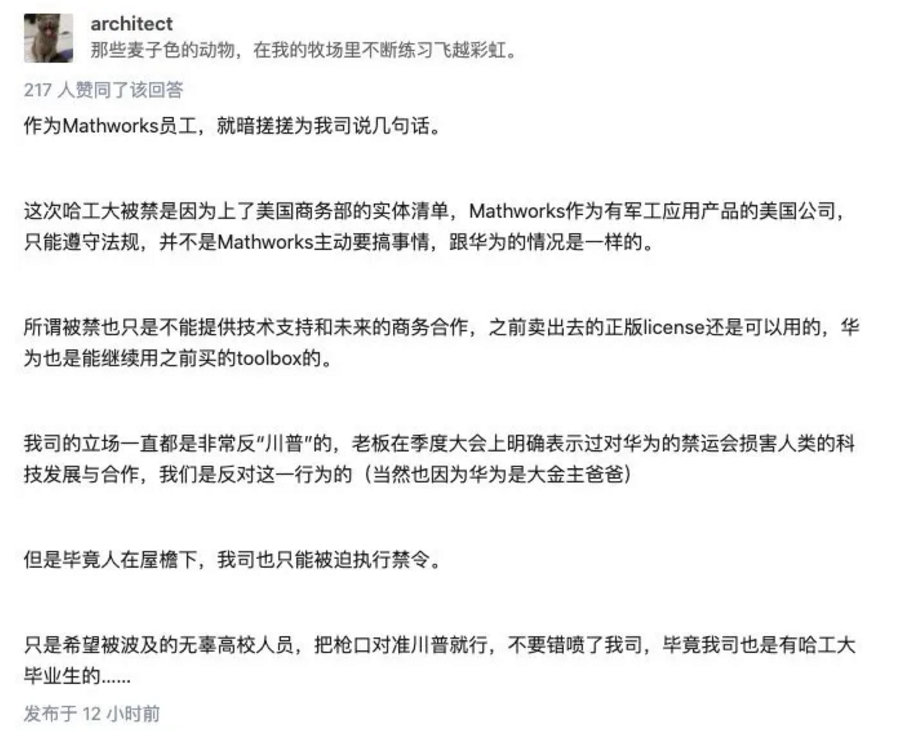
“The ban on Harbin Institute of Technology is due to the entity list issued by the U.S. Department of Commerce, which requires American companies with military applications to comply with regulations. This is not an action taken by the company itself.”
Currently, 13 Chinese universities have been stopped from using MATLAB:
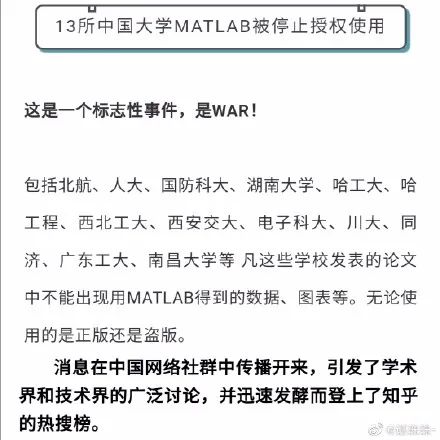
How important is MATLAB for engineering students? It is probably second only to the Office software that helped Microsoft dominate.
MATLAB was released in 1984 and is one of the three major mathematical software programs in the world, winning the favor of millions of engineers and mathematicians globally.
Due to its powerful functionality, after entering China, it swept through universities such as Tsinghua, Peking University, and Xi’an Jiaotong University. In fact, the first class of certain university majors is often dedicated to teaching students how to install MATLAB.
Simulation image created using MATLAB series tools
In the face of sanctions, some netizens have suggested using more open-source alternatives like Python and Julia. However, these alternatives are still far from MATLAB.
Some netizens optimistically claimed they could use pirated software, but this situation is even more dangerous. When publishing papers, one cannot cite charts and data obtained from MATLAB without copyright protection, which could lead to significant compensation claims. Before even graduating, one could end up bankrupt.
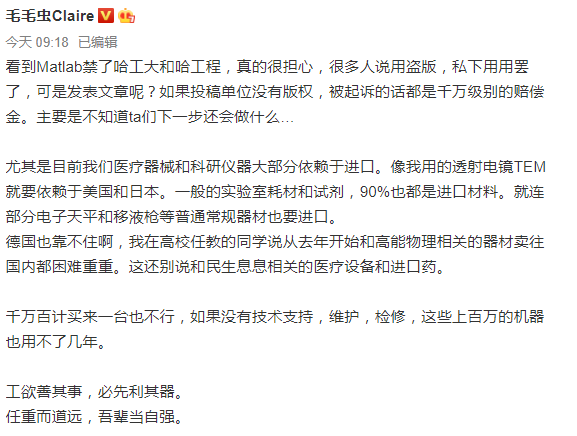
Weibo user @尘世间的凡夫俗子 stated:With so many IT elites like Huawei, Baidu, Alibaba, and Tencent, why has no one developed commonly used design software? Most commonly used design software is foreign; if we don’t develop our own, the gap will only widen.
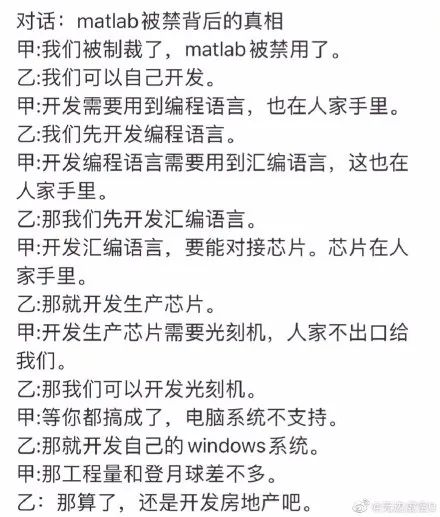
For example, CATIA, ProE, CAD, PS, CDR, Rhino, SolidWorks, MATLAB, etc. As for Office and CAD, we can rely on domestic products like WPS and Caxa.Moreover, industry experts have expressed:Seeing Harbin Institute of Technology banned from using MATLAB, I feel a deep sense of loss. China has millions of programmers earning over a million a year, yet we can’t even produce decent tool software. How can we talk about our vision?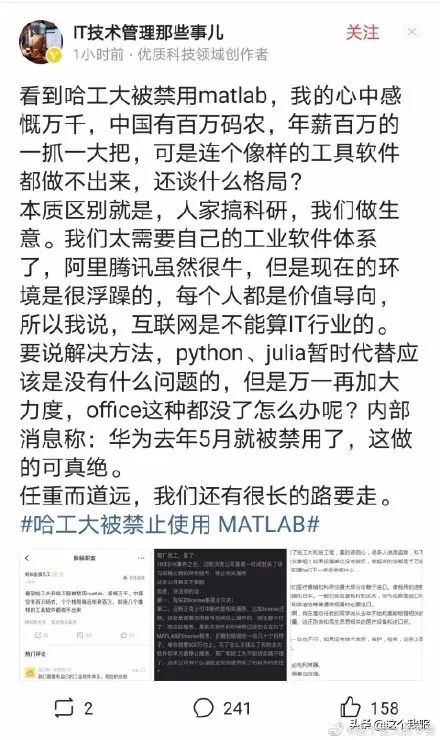 The essential difference is that they focus on scientific research while we focus on business. We desperately need our own industrial software system. Although Alibaba and Tencent are impressive, the current environment is very restless, and everyone is value-oriented. Therefore, I say the internet cannot be considered part of the IT industry.
The essential difference is that they focus on scientific research while we focus on business. We desperately need our own industrial software system. Although Alibaba and Tencent are impressive, the current environment is very restless, and everyone is value-oriented. Therefore, I say the internet cannot be considered part of the IT industry.

As for solutions, using Python and Julia as temporary substitutes should not be a problem, but what if the pressure increases and we lose Office as well? (PS: Actually, we have WPS)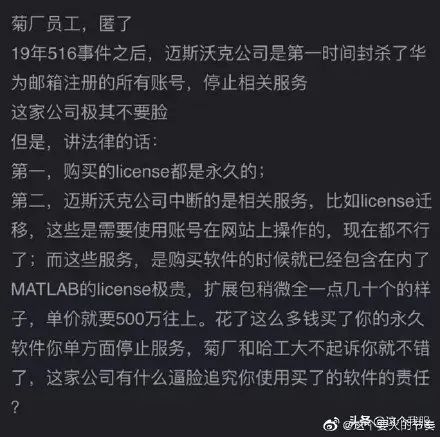
Internal news indicates that Huawei was banned last May, which is quite severe. The road ahead is long, and we have a long way to go.
Finally, let’s take a look at some heartfelt words from a senior Chinese-American programmer regarding domestic R&D!
Heartfelt words from a senior Chinese-American programmer regarding domestic R&D
Hello everyone, today I saw that Harbin Institute of Technology had its MATLAB authorization canceled by the U.S., leading to delays in various research projects. A graduate student from Harbin Institute of Technology lamented online that the gap between the engineering software industry and foreign countries is over 30 years!
MATLAB is just the tip of the iceberg; our dependence on overseas technology is beyond imagination. As a senior software engineer with over ten years of experience in the U.S. and a PhD background in science, I would like to discuss why this issue exists. Is it due to insufficient funding, low talent quality, or a lack of emphasis on the problem?
Firstly, we do have the world’s largest trading platform, Alibaba, but on the other hand, over 99.99% of industrial software requires authorization from the U.S. and Europe. This is fundamentally a matter of basic and applied levels; industrial software spans multiple foundational disciplines, while the application of pure information technology is limited. Without a solid foundation, upper-level applications can only imitate others…
Alibaba is indeed impressive, but can you say that it is an independent technology from the ground up? Even Jack Ma would hesitate to say that, as the concept of e-commerce was also learned from the U.S.
Take MATLAB as an example; can we independently design it? From an application perspective, Dr. Gu Yingqiong believes it is not difficult. This matter should be led by the state, with the Ministry of Education taking the lead and investing resources and funds to develop a Chinese version of MATLAB.
The purpose would be to provide it for use in domestic universities and enterprises. If all universities use it, there will be a market.
Some people think MATLAB is very powerful! Dr. Gu Yingqiong believes that if you break it down, the content inside is quite simple.
Algorithm modules have various open-source C++ and Python libraries. The front-end software interface is even simpler; it consists of modular components. The most important aspect is the various library functions you call. If a company integrates these open-source algorithms, it would be quite straightforward.
The truly technical aspect is the initial creation of algorithms, not just learning to call MATLAB’s library functions. Industrial software is challenging, and it is not merely a programming issue.
For example, if Dr. Gu Yingqiong wants to use industrial software to model a car, the software must support aerodynamics, materials science, mechanics, etc., to simulate real situations. This requires engineers to possess cross-disciplinary capabilities [covering face]
China does not lack programmers, nor is it necessary for them to understand your field. As long as you clarify your processes, the rest can be handed over to programmers.
The difficulty of software issues lies in the lack of a market ecosystem behind the software. The problem with engineering software also lies in research levels. The 30-year gap you mentioned between domestic and foreign can only be described as a 30-year gap in research levels (the specific gap is unclear); do not casually claim that software is 30 years behind.
Professional-grade software does not make money, and general companies are certainly unwilling to invest heavily in R&D. However, without R&D, there will be nothing; this is a vicious cycle.
China still has a significant gap with some Western countries in high-end technology, which is undeniable. Database technology has a market, and investment yields returns, so it can be heavily invested in. However, research software has a small market, complex algorithms, and a long road ahead…
Alas, the feeling of being choked by others is really unpleasant. Some domestic software has been developed, but most are not improved while being used; instead, they are directly compared with foreign software. If they are not good enough, they are simply abandoned, making it impossible for domestic software to develop. Now that foreign software is banned, there is a call for domestic software.
If a national consensus had formed from the beginning to fully develop domestic products systematically, Dr. Gu Yingqiong believes we would not be in such a painful and passive situation now.
However, from the current situation, the ban is for the best. If it were not banned, we would continue to rely on it. Although the impact in the next three to five years will be significant, at least it will show the upper management the shortcomings of industry software, and then companies will strive to enter this blank market.
It is not that non-domestic products cannot be used, but rather that we have become accustomed to the convenience of leading products. Domestic products will gradually emerge, and there will be a day of success as long as the motivation is sufficient; the problems will be solved. The difficulty in creating these software lies in the fact that those who can write programs do not necessarily have an engineering background.
Developing such software requires individuals with at least a master’s degree in engineering and high capabilities in the software field.
Such individuals are already scarce, and their salaries must be at least 300,000 a year (this is the most basic). Not to mention, Dr. Gu Yingqiong knows many so-called developers in China, and 80% of them are just coders!
Professional software engineers are even rarer! Industrial-grade software is meticulously crafted, requiring not only money but also the testing and validation of related personnel. To catch up, we must be grounded and practical.
This is not just a software issue; it is a problem of the entire foundation and scientific application. Simulation software’s core lies in mathematics, physics, and chemistry, along with software development. The technical difficulty of software development is not high!
What is meant to come will come. The gradual soft decoupling between China and the U.S. is better than a sudden hard decoupling; at least it gives relevant industry personnel in China a warning and a critical buffer time. From this perspective, it may not be a bad thing.
Many people think that developing software is not that difficult. If it is just about writing code and considering algorithms, it can certainly be figured out in a short time. However, as engineering simulation software, it is far from just writing code.
It involves a lot of foundational research work, clarifying the internal connections of various complex situations in the engineering field, while also making reasonable simplifications to ensure that the results closely align with engineering reality.
Having people and money is not enough; time and practical experience are also needed. Dr. Gu Yingqiong believes this is precisely what we lack and cannot quickly make up for.
There will hardly be any companies dedicated to researching such highly specialized software; they are either game companies or those promoting big data. Once it comes to very specialized software, they find it is all someone else’s.
In the short term, there is no profit, and subsequent needs require substantial professional investment. Unless it involves national security, there is basically no chance in China; there are no people and no money. Currently, people in China are too restless; few are focused on technology; most are just trying to make quick money and engage in capital operations.
For instance, the cameras I frequently use are from Sony, Panasonic, and Fujifilm. Domestic products simply cannot compete. Perhaps the lens patents have expired, allowing for imitation, but the algorithms for the main units can never be replicated. The truth is that China is still relatively backward in many aspects; we must recognize reality and not live in the grand dream of “My Great Country”.
There is a saying: Don’t reinvent the wheel! If one day the wheel is taken away from you, you can only walk.
Theoretically, these professional software programs require cooperation from universities, research institutes, and other scientific research units to be developed, and a batch of master’s and doctoral students must continuously iterate.
However, as everyone knows, the domestic research environment makes it very difficult to seriously do something; very few people can settle down to conduct research.
Not to mention, if the U.S. cuts off all basic software from China—Java is gone, Python is gone, C is gone, the entire suite of big data software is gone—what can we still do? These things cannot be developed in a year or two, so we should not be blindly optimistic. We need to think about how to improve the research environment, allowing people to utilize their talents and resources, which is a hundred times better than just shouting slogans.
The real problem in China does not lie here. In foreign countries, companies conduct R&D because once developed, it can be commercialized and turned into profit. Chinese companies do not engage in this; it is all research institutions doing the R&D. Why don’t companies do it? R&D requires massive funding, which must be converted into product profits to sustain R&D. However, China lacks patent protection; once a person is poached, the hard work is wasted, and the technology is taken away. Relying solely on research institutions, what can be developed? National civil servants have iron rice bowls; who will bother to put in that effort?
It feels like companies like Alibaba and Pinduoduo have changed the business landscape, making the shift from walking to running, significantly improving efficiency.
However, industrial software is akin to transitioning from crawling to standing upright; the speed may not be immediately apparent.But in one second, it goes from being an animal to being human.
Our focus has been on industries like real estate that can generate quick profits, while the most core and foundational elements are scarce!
The challenges of these software programs do not lie in the software itself, but in the models! Establishing models requires not only money and time but also talent.
Rome was not built in a day, but if given 30 years with the right approach, there will inevitably be a Rome that the world admires!
Source: All materials in this article are compiled from the internet.

Recommended Articles:
A 28-year-old programmer with options worth over a hundred million retires fiercely from ByteDance, netizens: So jealous!
Why can’t China develop popular operating systems and programming languages?
With an average of 700 million transactions daily, why do we use MySQL?